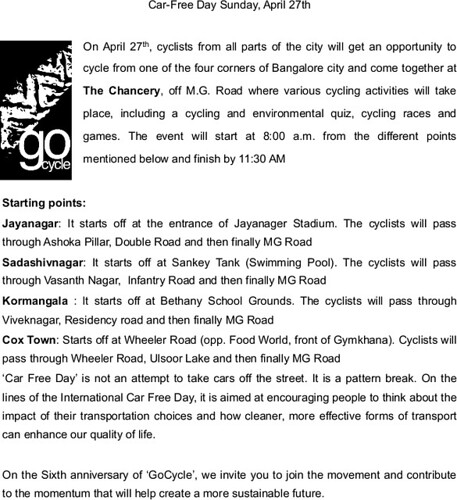Meeting Mr. Dastagir Sharif - Chief Traffic Manager, Bangalore Metropolitan Transport Corporation (BMTC)
Notes on yesterday's meeting with Mr Dastagir Sharif:
1. The website is outdated. Can it be updated for good route lookup?
Ans: The previous guy working on the website was not good. They have engaged an "agency" and soon, the website will be live. He did not tell us when exactly it will become live (we asked him multiple times). He showed us a map of all the bus stops marked on a large-scale map of Bangalore. Apparently marking the bus stops was a non-trivial task.
2. Can we have a graphic map, overlaying all bus routes?
Ans: Maps were created, and lots of bus stops have such maps. But there is too much vandalism, and all these maps have been destroyed. Moreover, because Bangalore is not a well-planned city, we cannot create the kind of bus maps that London and NYC have (!!!).
3.Can you time buses so that you prevent bunching up of buses, and keep them flowing at regular intervals?
Ans: Given the current traffic situation this is very difficult. The policymakers do not have the will to keep buses and other traffic orderly and prevent roadblocks. Without orderly traffic, BMTC cannot do much about ensuring these "timely" buses.
4. Can English be added to the boards?
Ans: Just two days back, he had a meeting with some folks from the Karnataka Rakshana Vedike. The BMTC is sponsoring a trip for them to see other cities in India so that they see that English is used everywhere. Maybe after that, they can put English on the buses in Bangalore (!!!).
5. Is there a plan for BRT pilots?
Ans. Yes, especially on outer ring road (where the bus frequencey is every 2-3 minutes) and the road to the new airport. These two roads are being targetted because they are 6-lane roads. He is trying to push for them.
6. Are you planning new buses and routes?
Ans: There is a plan to increase fleet to 10,000 in the coming years, 800 this year alone. But it is difficult because they are not getting enough trained drivers. Recently, they've put out job availabilies for 3500 drivers, but they have received only 2300 applicants. He claims that a bus driver job is not as attractive today as it used to be given the other options people have. Another 6500 positions have been advertised.
7. Other gripes about increasing number of buses and constructing bus shelters:
Ans: He runs into problems with the deputy commisioner of police. Apparently, the police do not want to see more buses because they feel it will lead to more congestion. Moreover, BBMP does not give them permission to construct more bus shelters. They've tried to get permission but haven't been able to.
8. On buses converting to CNG:
Ans: They are ready to do this if the Govt. "agrees" to it. I think that means providing the money to convert the buses.
9. How about introducing more Volvo/high-end buses?
Ans: Volvo buses are loss making. They have already ordered more of these buses, but they seem not to be sustainable. Even the Suvarna buses, which are only marginally more expensive than regular buses, are making losses. So he does not have much of an intent to increase high-end buses. The reason, he says, is that people with enough money to travel in such buses consider it beneath themselves to ride in public transport.
10. Lots of bus stops are just before or after important traffic junctions. Can he remedy that?
Ans: A lot of this has already been done, and they are actively working on this problem.
11. How about introducing Point-to-point buses with few stops
Ans: He talked about the Suvarna buses, and how they are loss-making.
12. Why not have smaller buses shuttling within the same area?
Ans: There are already 16 such routes, and they plan to introduce 19 more by the end of the year. He gave us a list of the 16 routes: Here they are:
FDR-1 From Uttarahall to Uttarahalli
FDR-2 From Uttarahalli to Uttarahalli
FDR-3 From ISRO Layout to ISRO layout
SJP.FDR-2 From Jn. of Hosur Road to Sarjapura
HSR.FDR-1 From Madivala to Chandrapura
BGT.FDR-1 From Bangalore Dairy Circle to Bannerghatta
374-E from Chikkalasandra to Chikkalasandra
374-F from Chikkalasandra to Chikkalasandra
500-Q From Goraguntepalya
258-CB from Goverdhan to Hesaraghatta
NMG.FDR-1 From Peenya 2nd Stage to Chikkabanawara
NMG.FDR-2 from Goverdhan to Hesaraghatta
240-R from Magadi Road tollgate to Gollarahatti
501-F from Kottigepalya to Kottigepalya
501-D from Kottigepalya to Kottigepalya
HSK.FDR-1 from KR Puram to Hosakote
However, the one in Koramangala was a complete disaster ( to and from the Mall), so he has discontinued that one.
13. How can we help?
Ans. Work through the press to increase support for the two BRT pilots. Also increase awareness in middle-class people and encourage them to use the bus.
Participants : Deepa Mohan, Nithin Shenoy, Ranjita Bhagwan & Anush Shetty
Thanks to Ranjita for the notes
Labels: bmtc, buses, infrastructure, public transport, transportation



